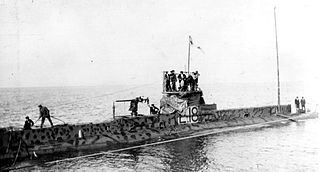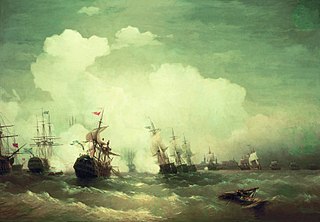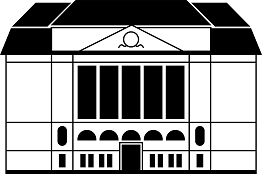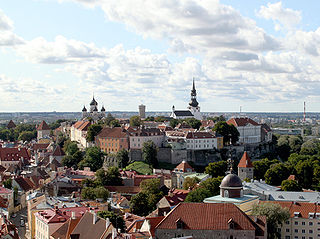 W
WThe Baltic Fleet is the fleet of the Russian Navy in the Baltic Sea.
 W
WThe British campaign in the Baltic 1918–19 was a part of the Allied intervention in the Russian Civil War. The codename of the Royal Navy campaign was Operation Red Trek. The intervention played a key role in enabling the establishment of the independent states of Estonia and Latvia but failed to secure the control of Petrograd by White Russian forces, which was one of the main goals of the campaign.
 W
WA British submarine flotilla operated in the Baltic Sea for three years during the First World War. The squadron of nine submarines was attached to the Russian Baltic Fleet. The main task of the flotilla was to prevent the import of iron ore from Sweden to Imperial Germany. The success of the flotilla also forced the German Navy in the Baltic to keep to their bases and denied the German High Seas Fleet a training ground. The flotilla was based in Reval (Tallinn), and for most of its career commanded by Captain Francis Cromie.
 W
WThe Bronze Night, also known as the April Unrest and April Events, refers to the riots in Estonia surrounding the controversial 2007 relocation of the Bronze Soldier of Tallinn, the Soviet World War II memorial in Tallinn.
 W
WThe Brotherhood of Blackheads is an association of local unmarried merchants, ship owners, and foreigners that was active in Livonia from the mid-14th century till 1940 but still remains active in present-day Hamburg. The Brotherhood of Blackheads was founded as a military organization but the non-military aspects of the association gradually became more pronounced until the Brotherhood became a predominantly social organization after the end of the Great Northern War.
 W
WCanute Guild was a guild in Tallinn, Estonia. The guild was named after Knud Lavard.
 W
WThe coat of arms of Tallinn represents the Estonian capital of Tallinn. Tallinn is located in Harju County, Estonia.
 W
W2011 Estonian Ministry of Defence attack was an attack on the Estonian Ministry of Defence building in Tallinn on 11 August 2011 by Karen Drambjan. He was shot dead in a firefight with the police, after he set off several explosives.
 W
WThe flag of Tallinn consists of three blue and three white horizontal bars. The ratio of length and width is 2:1 and normal size is 1600×800 mm.
 W
WAbram Petrovich Gannibal, also Hannibal or Ganibal, or Abram Hannibal or Abram Petrov, was a Russian military engineer, general, and nobleman of African origin. Kidnapped as a child, Gannibal was taken to Russia and presented as a gift to Peter the Great, where he was freed, adopted and raised in the Emperor's court household as his godson.
 W
WThe Great Guild was a guild for merchants and artisans, operating in Tallinn from at least the 14th century until 1920. It was based in the Great Guild hall, a Gothic building in the historical centre of Tallinn, today housing the Estonian History Museum.
 W
WThe Gustav Adolf Grammar School is a secondary school in Tallinn, Estonia. Swedish king Gustavus Adolphus established it as the Reval Gymnasium in 1631. It is one of the oldest extant secondary schools in Europe.
 W
WThe Hirvepark meeting was held in Estonia on 23 August 1987 in Hirvepark, the anniversary of the Nazi-Soviet Pact. It was attended by 2,000 to 5,000 people, and was one of the first organized public demonstrations against the Estonian Communist Party. It sparked a wave of anti-Soviet activity and mass protests in support of independence.
 W
WKiek in de Kök is an artillery tower in Tallinn, Estonia, built in 1475. It gained the name Kiek in de Kök from the ability of tower occupants to see into kitchens of nearby houses. The tower is 38 m high and has walls 4 m thick. Cannon balls dating back to 1577 are still embedded in its outer walls.
 W
WLasnamäe Airfield was an airfield in Tallinn, Estonia. It was located 5 km (3.1 mi) east of the city centre on the hill of Lasnamäe. Nowadays its former runway and taxiways are covered by apartment buildings and a street network. The newer Tallinn Airport is also located in Lasnamäe but 4.5 km (2.8 mi) south-southwest.
 W
WCharles Leroux was an American balloonist and parachutist.
 W
WThe Battle of Lyndanisse was a battle during the Livonian Crusade, fought between the Kingdom of Denmark with various German allies and pagan Estonian tribes. The battle helped King Valdemar II of Denmark establish the territory of Danish Estonia during the Northern Crusades, which were undertaken in response to calls from the Pope. The Danes defeated the Estonians at Lindanise.
 W
WMagnus of Denmark or Magnus of Holstein was a Prince of Denmark, Duke of Holstein, and a member of the House of Oldenburg. As a vassal of Tsar Ivan IV of Russia, he was the titular King of Livonia from 1570 to 1578.
 W
WThe Meredessantpataljon, was a short-lived Estonian marine infantry battalion during the Estonian War of Independence of the Estonian Defence Forces subject to the Estonian Navy. The battalion was created from the crews of the Estonian surface warships, students and Finnish volunteer soldiers. The battalion was created and later disbanded in Tallinn after it had fulfilled its military objectives in 1919.
 W
WThe Mõigu cemetery, Estonian: Mõigu kalmistu) was a large Baltic German cemetery, located in the Tallinn suburb of Mõigu in Estonia. It served as the primary burial ground for the usually wealthy and noble citizens of the Toompea parish of Tallinn. Containing numerous graves, it stood for over 170 years from 1774 to shortly after World War II when it was completely flattened and destroyed by the Soviet occupation authorities governing the country at that time.
 W
WNaval Blockade of Reval (1726)
 W
WTallinn Old Town is the oldest part of Tallinn, Estonia.
 W
WArent Passer was a stonemason and architect of Dutch origin. He was born in The Hague and worked in Tallinn from 1589 until his death. Arent Passer is buried in St. Olaf's church in Tallinn.
 W
WThe Raeapteek is a pharmacy in the center of Tallinn, Estonia.
 W
WThe Reval German Theater was the second theater building and the first professional theater in the city of Tallinn in Estonia, founded in 1795 and closed in 1939. It was named (German) Revaler Theater or (Estonian) Tallinna Teater in 1809-1860, (Estonian) Tallinna Linnateater or (German) Revaler Stadttheater in 1860-1910, and Tallinna saksa teater in 1910-1939. Its building is now used by the Estonian Drama Theatre.
 W
WThe naval Battle of Reval took place on 13 May 1790 during the Russo-Swedish War (1788-1790), off the port of Reval.
 W
WThe Russalka Memorial is a bronze monument sculpted by Amandus Adamson, erected on 7 September 1902 in Kadriorg, Tallinn, to mark the ninth anniversary of the sinking of the Russian warship Rusalka, or "Mermaid", which sank en route to Finland in 1893. It was the first monument in Estonia made by an Estonian sculptor. The monument depicts an angel holding an Orthodox cross towards the assumed direction of the shipwreck. The model for the angel was the sculptor's housekeeper Juliana Rootsi, whose grandson is the politician, Tiit Made.
 W
WSt. Nicholas Church is a medieval former church in Tallinn, Estonia. It was dedicated to Saint Nicholas, the patron of the fishermen and sailors. Originally built in the 13th century, it was partially destroyed in the Soviet bombing of Tallinn in World War II. It has since been restored and today houses the Niguliste Museum, a branch of the Art Museum of Estonia, focusing mainly on ecclesiastical art from the Middle Ages onward. The former church is also used as a concert hall.
 W
WSt. Olav's Guild was a guild in Tallinn, Estonia. The guild was named after Olaf II of Norway.
 W
WJohan(n) Gustav Stockenberg was a Swedish sculptor, wood carver and stonemason who worked in Sweden, Russia and mainly in Reval.
 W
WThe German Luftwaffe and Soviet Long Range Aviation bombed the Estonian capital Tallinn several times during World War II. The first instance was during the Summer War of 1941. A number of bombing missions followed in 1942–43.
 W
WTallinn Legends - is a tourist attraction in a form of theatrical and interactive museum in Tallinn, Estonia. The museum recreates historical events and legends that have contributed to the folklore of medieval Tallinn . It uses a mixture of storytelling, live performances and special effects.
 W
WThe Tallinn Power Plant is a former power plant located in Tallinn, Estonia. Construction of the power plant was initiated by Volta company and it was decided by the Tallinn City Council in 1912 after the work of special committee established in 1909. The plant was located next to the Tallinn Gas Factory at the location of the former Stuart fortress. The plant was designed by Volta and the architect was Hans Schmidt. Originally it used three Laval-type 250 horsepower (0.19 MW) steam turbines and three 250 horsepower (0.19 MW) electric generators—all produced by Volta. Two coal-fired boilers were manufactured by AS Franz Krull. The power plant was opened on 24 March 1913 and originally it was fired by coal. In 1919–1920 the plant was expanded and transferred to peat and wood. In 1924 the power plant was switched to oil shale. It was the first power plant in the world to employ oil shale as its primary fuel. In 1939, the plant achieved capacity of 22 MW.
 W
WTallinn School No. 21 is a secondary school in Tallinn, Estonia. The school was founded as the Tallinn kroonualgkool No. 21. The first schoolhouse was a wooden house on J. Poska 6a. In 1923–1924 as the number of students grew, a new schoolhouse was needed.
 W
WTondi Elektroonika, formerly known as Tallinna Pooljuhttakistite Tehas, Hans Pöögelmanni nimeline Tallinna Raadiotehnika Tehas and Hans Pöögelmanni nimeline Elektrotehnika Tehas, as well as Factory number A-1381 was a factory of electrotechnical components located in Tallinn, Estonia. It was a significant component of the Soviet Military-industrial complex.
 W
WTõnismägi is a 36-metre high hillock adjacent to Toompea hill in Tallinn, Estonia. From 1945 to 1996 the central portion of the hillock was called Liberators' Square. The place became internationally known in 2007 when the Estonian government relocated a Soviet war memorial known as the Bronze Soldier. Tõnismäe is also a subdistrict in the district of Kesklinn with a population of 1,404.
 W
WToompea is a limestone hill in the central part of the city of Tallinn, the capital of Estonia. The hill is an oblong tableland, which measures about 400 by 250 metres, has an area of 7 hectares and is about 20–30 metres higher than the surrounding areas. In folklore the hill is known as the tumulus mound over the grave of Kalev, erected in his memory by his grieving wife.
 W
WToompea Castle is a castle on Toompea hill in the central part of Tallinn, the capital of Estonia. The castle, an ancient stronghold site in use since at least the 9th century, today houses the Parliament of Estonia.
 W
WThe Walls of Tallinn are the medieval defensive walls constructed around the city of Tallinn in Estonia.